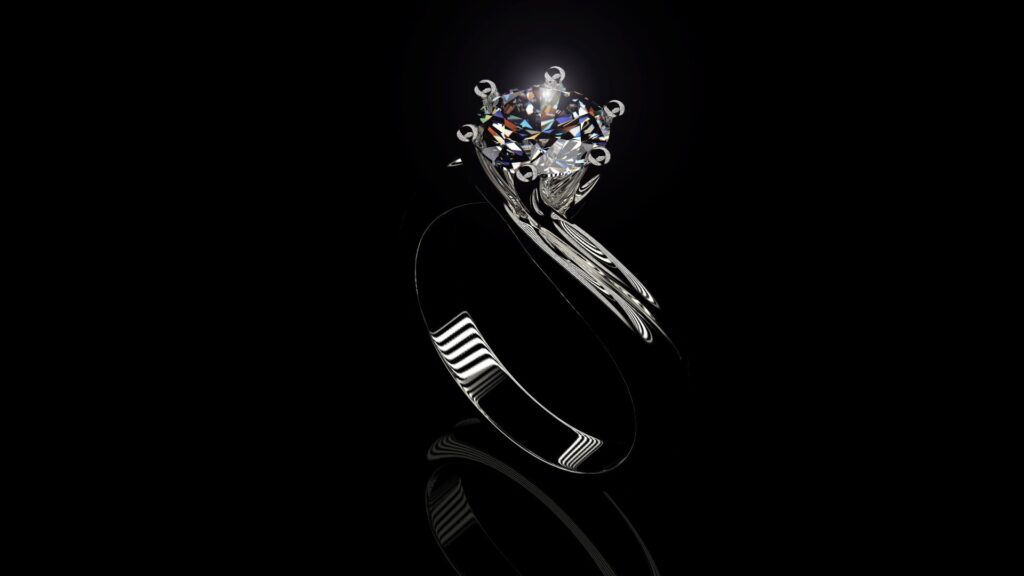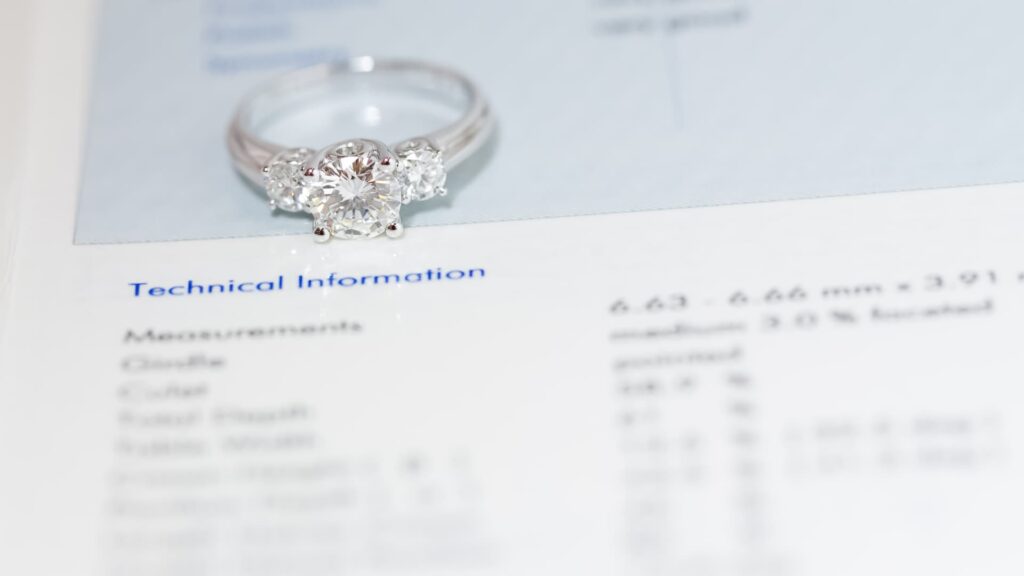Lower color grades on a diamond scale do not always equate to an underwhelming diamond. While most people do not like the way color affects the diamond’s appearance, there are others who are fond of warm-toned diamonds.
Anyway, both I and J color diamonds can be the go-to option for anyone who’s in search of affordability alongside a gorgeous colorless diamond.
I and J color diamonds are categorized in the ‘Near Colorless’ range of the GIA color scale. You can check that out in the image below:

With belonging to the second-best category on the color scale, I and J diamonds are sure to catch your eye. But are they really prized as much as the higher color grades?
Well, let’s find that out and have a quick comparison between these two ‘Near Colorless’ grades.
What is I, Color Diamond?
An I color grade is the second last grade in the ‘Near Colorless’ range of the GIA color scale. It is followed only by a J color grade, but that doesn’t make it anywhere near a poor choice.
An I color diamond still sits in the ‘Near Colorless’ range, which means that it shows minimal yellowish hues in its appearance. This slight tint is hardly ever identifiable by an untrained and unaided eye, especially when observed in isolation.
The extent to which a diamond shows color depends greatly upon its shape. Some shapes, such as round brilliant, are amazing at masking away the color in a diamond, while others, such as a pear or Asscher cut, may not be the best friend of a saturated diamond.
Anyway, the slight hue in an I-color diamond is certainly not noticeable when it sits in a setting. In fact, in a face-up view, an color diamond will be hard to discern from a G color diamond when observed in isolation.
Look at the face-up view of an I-grade diamond:
The color in the face-up view image is hardly noticeable. However, the diamond will show color in a side profile view but let’s not worry about it because the side profile of a diamond is almost always concealed in a setting.
What is J Color Diamond?
The J color stands last in the Near Colorless category. It is only one step ahead of the K grade from the Faint Yellow range. And unlike the popular opinion, a J color diamond does not reveal any major hue.
The fact that a J grade is categorized among the Near Colorless diamonds should be enough to put your concerns to rest. It shows a minimal yellowish tinge that is barely noticeable by an untrained eye.
Look at the image of a J color diamond below:
You probably cannot tell how yellow it is unless you compare it with the following image of a G color diamond:
Of course, there is a difference, and a J color diamond appears warmer toned than the G color diamond that stands first in the same range. However, in a face-up examination, this slight hue typically does not bother an average consumer.
A J color diamond in the right shape and setting can look quite incredible and save you lots of money at the same time. The slight yellow tone of a J diamond shouldn’t be a matter of concern as long as you pick a setting and shape that settles down the color of the diamond.
What is the difference between I and J Color Diamond?
Well, you won’t be finding any major distinguishing factors between an I and J color diamond. And that’s because they stand only one grade apart from each other, that too, in the same ‘Near Colorless’ category.
To a naked, untrained eye, I and J color diamond will essentially look the same. You can’t really tell them apart. But for experts, they’re two different grades, and hence, there ought to be something peculiar about each.
So here’s what we found from our observation.
J Color Diamond shows a more visible hue.
While the difference of color between a J and I color diamond to an unaided eye is unidentifiable, experts can spot a J diamond by its higher degree of a yellow/brown tinge.
A J color diamond shows a noticeable warmth in its appearance. If we compare a G color diamond to a J color diamond on the one hand and, on the other hand, compare a G vs. I diamond, you’ll see the color difference between G vs. J diamond will be far more than the other set.
Look at the following images of a G, I, and J color diamond, respectively:
The difference between G and I diamond is not so much, right? But the J color diamond is visibly more on the yellow side. So while they’re only one grade apart from each other, the amount of saturation is clearly higher in a J color diamond.
I Color Diamond costs slightly more.
It is obviously a well-known fact that as you move down on the GIA scale of color, clarity, or cut grade, the price of the diamond drops significantly.
Therefore, the I color diamond being one grade superior to the J color diamond, costs a little more. Since there is not a significant difference in their appearance, the price difference is also not huge.
However, as the caratage of the diamond increases, the price difference becomes higher. And since the I color grade is considered better out of the two, it fetches a higher price. On the contrary, J color being closer to the Faint Yellow category will not put a toll on your budget as much.
J Color Diamond is closer to Faint Yellow.
Standing last in the Near Colorless range puts the J color in a position closer to the Faint Yellow category of the GIA color scale. A J color diamond in all its glory can look as outstanding as an H color diamond.
However, in a poor cut or shape, it can closely resemble a K-color diamond too. So a J color grade is kind of in a position that often leaves it unpreferable among consumers because they’re looking for diamonds with less visible color.
I vs. J Color Diamond: Which is better?
Well, there isn’t much difference between I and J color diamonds. Both of these color grades are on the lower end of the Near Colorless category, so you can expect a similar performance from them.
I and J color diamonds both can prove to be splendid choices. A wise and thoughtful purchase of either of these can lead you to save a large sum of money while still getting a diamond that looks as good as colorless to an unaided eye.
When choosing an I or J color diamond, always root for shapes that are good at concealing the warm shade in the diamond. The best option in this regard is a brilliant round cut, while the worst choice can be a pear or Asscher cut.
Look at these images of I color round brilliant and pear-shaped diamonds below:
The only difference between these diamonds is their shape, yet you can clearly see how very intensely the pear shape reveals the color of the diamond. This is mainly because brilliant round diamonds showcase an excellent light performance, and their sparkle masks the unwanted color.
Anyway, apart from the shape of the diamond, you should also consider sticking to yellow or rose gold settings only. The yellow color of the setting tones down the yellow tinge in the diamond. As opposed to that, platinum or white gold setting highlights the color of the diamond more.
Next, if you’re getting an I or J color diamond, you’re also bound to keep the carat weight of your diamond below or up to 2 carats only. As the size of your diamond gets bigger, the color becomes more noticeable.
However, this shouldn’t be much of an issue for people who admire warmth in their diamonds. But those of you who do not want a noticeable color in their diamond, keep the carat weight lower than 2.
In essence, there’s no better option when it comes to choosing between an I and J color diamond. Both are quite promising options as long you keep these basic hacks in mind.
Price Comparison: I vs. J Color Diamond
Despite the fact that the I and J color diamonds resemble quite closely to each other, you’ll see a significant jump in the price as you move from a J to an I color grade.
Let’s take you through a quick price comparison between I and J color diamonds. Starting off with diamonds at James Allen. The following features for both diamonds will stay the same:
- Carat: 2.00
- Clarity: VS1
- Cut: Ideal
A diamond with the aforementioned features and an I color grade will cost you around $21,900. In contrast to that, if we consider the J color grade of the same diamond, the price significantly drops to $17,600.
However, you may not always find the price difference to be major as such. It varies from diamond to diamond and, of course, the diamond vendors as well.
For instance, at the Blue Nile, a 2ct. VVS2 diamond with an I color grade fetches a price of $23,100. A similar diamond with a J color grade will cost you $21,200.
Anyway, the prices of diamonds vary quite largely based on their rarity, value, performance, etc. You may even find some J color diamonds at a price higher than I color diamonds with the same features. So you really need to find out what gives you the best value for your money!
Final Verdict
Both I and J color diamonds are equally amazing choices. They are near colorless diamonds, and contrary to the common belief, they do not look yellow. Especially in a face-up view, both I and J color diamonds can look as appealing as a G color diamond without costing you a fortune.
Related articles:
D vs. F Color Diamond
Does James Allen Use Real Diamonds?
Is It Normal for Diamonds to Fall Out of Rings?






